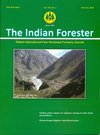Forest Resource Utilization Pattern and Heterogeneity in Rural Household Characteristics in Garhwal Himalaya
DOI:
https://doi.org/10.36808/if/2018/v144i2/122506Keywords:
Conservation, Consumption, Livelihood, Off-Farm Activities, Utilization.Abstract
Forest utilization pattern and extent among rural households varies differentially, affecting forest conservation and poverty reduction related policies and programmes. The present study attempts to analyze household characteristics facilitating forest resource use by rural households of Pauri Garhwal and Rudraprayag districts of Garhwal Himalaya, so that programmes may be tuned and optimized for better outcomes. Data on relevant household's parameters and forest resource use were collected from 454 randomly selected households distributed in three altitudinal ranges across the districts through multi-stage random sampling technique. The results of analysis showed that households' use forests for variety of purposes and most commonly used forest resources were fuelwood for energy, grass and leave fodder for livestock, leaf litter for composting and stone for construction purpose. The results of factor analysis revealed that decision factor, locational factor and household economic strengths were the most significant parameter in regulating forest resources use by the households. The results also reveals that the livelihoods of rural communities in Garhwal region is dependent on forest resources and varied household attributes were the prime cause for differential uses of forests. Therefore schemes and rural development programmes focusing on household attributes are needed to strengthen household's internal (education and health) and external (economic and social) settings along with forest conservation.References
Babulo B., Muys B., Nega F., Tollens E., Nyssen J., Deckers J. and Mathijs E. (2009). The economic contribution of forest resource use to rural livelihoods in Tigray, Northern Ethiopia. For. Policy Economics, 11:123-131.
Bhatt B.P. and Sachan M.S. (2004). Firewood consumption along an altitudinal gradient in mountain villages of India. Biomass Bioenergy, 27(1):69-75.
Bhatt B.P., Negi A.K and Todaria N.P. (1994). Fuelwood consumption pattern at different altitudes in Garhwal Himalaya. Energy, 19(4):465468.
Cavendish W. (2000). Empirical regularities in the poverty-environment relationship in rural households: Evidence from Zimbabwe. World Development, 28(11):1979-2003.
Dhanai R., Negi R.S., Parmar M.K. and Singh S. (2014). Fuelwood and fodder consumption pattern in Uttarakhand Himalayan watershed. Inter. J. Environmental Biology, 4(1):35-40.
FAO (1994). Rural households and sustainability: Integrating environmental and gender concerns into home economics curricula. http://www.fao.org/docrep/V5406e/ v5406e02.htm (accessed on 24/8/2017).
FSI (2015). Forest Survey of India. India state of forest report 2015, MoEF, New Delhi.
G.B. Pant University (1980). Integrated natural and human resource planning and management in the hills of U.P. Pantnagar: progress report of sub-project: Study of Grassland and Livestock Resources Management in the Kumaun Hills.
Gaur R.D. and Sharma J. (2011). Indigenous knowledge on the utilization of medicinal plant diversity in the Siwalik region of Garhwal Himalaya, Uttarakhand. J. Forest Science, 27(1):23-31.
GOI (2014). Uttarakhand action plan on climate change. http://www.moef.gov.in /sites/default/files/Uttarakhand%20SAPCC.pdf.
IMD (2016). Rainfall statistics of India - 2015. India Meteorological Department (Ministry of Earth Sciences). Report no. ESSO/IMD/HS R. F. REPORT/04(2016)/22.
Joshi G. and Negi G.C.S. (2011). Quantification and valuation of forest ecosystem services in the western Himalayan region of India. Inter. J. Biodiversity Science Ecosystem Services Management, 7(1):2-11.
Khuman Y.S.C., Pandey R. and Rao K.S. (2011). Fuelwood consumption patterns in Fakot watershed, Garhwal Himalaya, Uttarakhand. Energy, 36(8):4769-4776.
Kumar M. and Sharma C.M. (2009). Fuelwood consumption pattern at different altitudes in rural areas of Garhwal Himalaya. Biomass Bioenergy, 33:1413-1418.
Kumar M., Bussmann R.W., Joshi M. and Kumar P. (2011). Ethnomedicinal uses of plants close to rural habitation in Garhwal Himalaya, India. J. Medicinal Plants Research, 5(11):2252-2260.
Maikhuri R.K., Rao K.S. and Saxena K.G. (2004). Bioprospecting of wild edibles for rural development in the central Himalayan mountains of India. Mt. Research and Development, 24(2):110-113
Mitchell R. (1979). An analysis of Indian agroecosystem. New Delhi, India: Interprint.
Pandey R. (2009). Forest resource utilization by tribal community of Jaunsar, Uttarakhand. Indian Forester, 135(5):655-662.
Pandey R. (2010). Heterogeneity in household characteristics, forest resource utilization and sustainability in Hills of Uttaranchal: A Case Study. Silva Lusitana, 18(1):75-84.
Pandey R. (2011a). Consumption and valuation of livestock fodder under different forest types of Himalayas, India. Silva Lusitana, 19(2):207219.
Pandey R. (2011b). Forest biomass extraction for livestock feed and associated carbon analysis in lower Himalayas, India. Mitig. and Adaptation Strategies for Global Change, 16:879-888.
Pandey R. and Jha S.K. (2012). Climate vulnerability index - measure of climate change vulnerability to communities: a case of rural Lower Himalaya, India. Mitig. Adaptation Strategies for Global Change, 17:487-506.
Pandey R., Harrison S. and Gupta A.K. (2014). Resource availability versus resource extraction in forests: Analysis of forest fodder system in forest density classes in lower Himalayas, India. Small Scale Forestry, 13(3):267-279.
PROFOR (2013). United Nations Forum on forests. Environment & Forests, Government of India, New Delhi.
Rawat A.S. (2002). Garhwal Himalaya: A study in historical perspective. Published by M.L. Gidwani, Indus Publishing Company. ISBN: 817387-136-1.
Shackleton C.M. and Shackleton S.E. (2004). The importance of non-timber forest products in rural livelihood security and as safety-nets: A review of evidence from South Africa. S. African Journal Science, 100:658-664.
Sharma C.M., Butola D.S., Gairola S., Ghildiyal S.K and Suyal S. (2011). Forest utilization pattern in relation to socio-economic status of People in Dudhatoli area of Garhwal Himalaya. For. Trees Livelihoods, 20:249-264.
Sharma C.M., Gairola S., Ghildiyal S.K. and Suyal S. (2009). Forest resource use patterns in relation to Socio-economic status: A case study in four temperate villages of Garhwal Himalaya. Mt. Research Development, 29(4):308-319.
Twine W., Moshe D., Netshiluvhi T. and Siphugu V. (2003). Consumption and direct-use values of savanna bio-resources used by rural households in Mametja, a semi-arid area of Limpopo province, South Africa. S. African J. Science, 99:467-473.
Warner K. (2000). Forestry and sustainable livelihoods: What part can forests and forestry play in reducing poverty? Unasylva, 202(51):3-12.
Yang W.Y. (1971). Methods of farm management investigation. Agricultural development paper No. 8. FAO: Rome.
Downloads
Downloads
Published
How to Cite
Issue
Section
License
Unless otherwise stated, copyright or similar rights in all materials presented on the site, including graphical images, are owned by Indian Forester.





